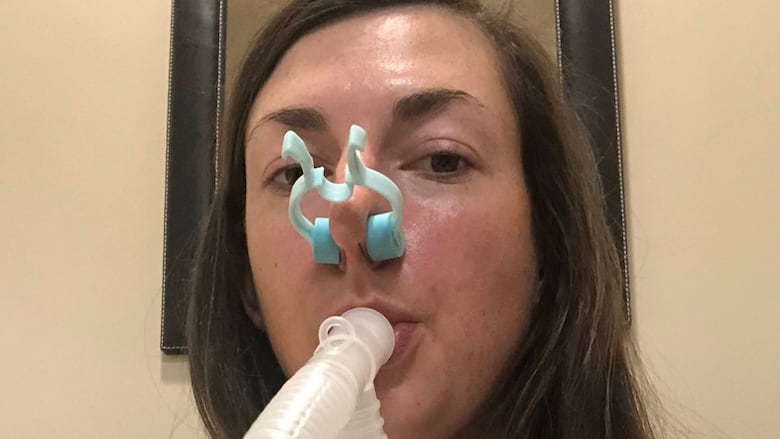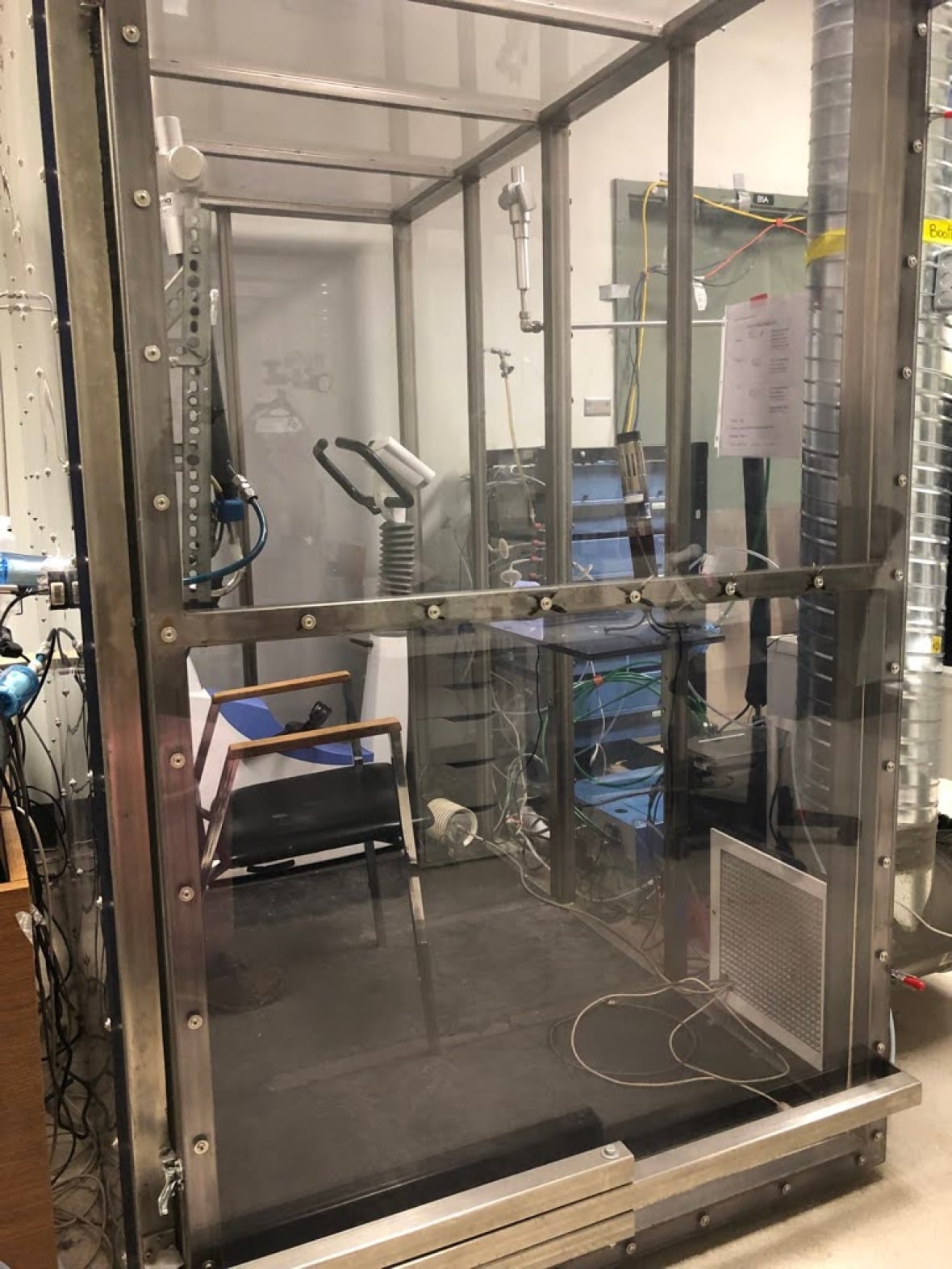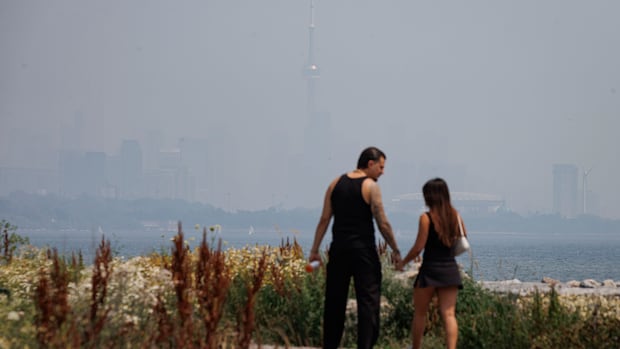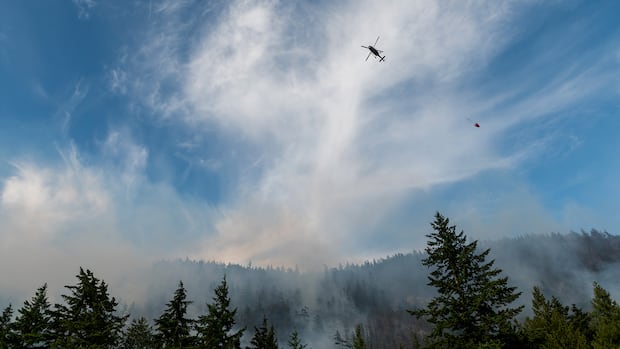This lab asks research volunteers to breathe in toxic fumes — and they do it willingly
UBC's Air Pollution Exposure Lab tests how poor air quality can influence our physical health


Ask Dr. Chris Carlsten about the clear booth in his University of British Columbia (UBC) laboratory, and he'll reassure you that it's perfectly safe — even if volunteers spend multiple sessions in the chamber breathing in polluted air.
"The duration varies, but the standard is two hours in that booth with Wi-Fi, with ability to basically use their computer, books, study, whatever," said Carlsten, head of the Air Pollution Exposure Lab (APEL) at UBC and Canada Research Chair in occupational and environmental lung disease.
As wildfire smoke has a worsening effect on air quality in Canada, the lab is one of the only facilities of its kind in Canada gathering pinpoint data to provide insight into the ways poor air quality is harmful to human health and wellness.
Despite the prospect of standing in a polluted chamber, Carlsten and his research team say volunteers have been eager to give their time.
"They are simply drawn to contribute to science and our attempt to solve a major public health problem," said Carlsten, via email.
Air pollution chamber at the heart of lab
Established by Carlsten in 2007, APEL runs their tests using devices that produce pollution and pump that dirty air into a polycarbonate testing chamber.
"We have a diesel engine, we have a furnace for burning wood for wood smoke, we have a device that creates microplastics because microplastic is an emerging concern," he said.

Researchers can even fill the chamber with allergens, like dust mites.
The key to maintaining volunteer safety is that researchers dilute pollutants to levels roughly matching those found in major urban centres.
"[Pollution] will be created by the engine or the furnace and then diluted by filtered air down to a safe level," said Carlsten.
The lab's data is published in a range of journals, and highlights how air pollution affects everything from lung performance during physical activity to the health of people with asthma and even on cognition.
Carlsten says his team's findings have also influenced policy, including at the U.S. Environmental Protection Agency.
Why would anyone want to breathe in polluted air?
The program's volunteers range in age from people in their 20s to their 70s, with near gender parity. Carlsten says volunteer demographics are quite broad, adding he believes results are applicable to more general populations. The lab's air quality studies follow strict double-blind research standards.
Volunteers, like Alana Green, say they often can't tell whether they're breathing in polluted air or clean air.
Green, an administrator at UBC, signed up for an air quality study when she first started working at the university.
"I felt like it was a way that I could contribute to science and to society by participating in this," she said.
Taking part between January and December 2023, Green, who travels internationally, said air in the chamber didn't compare to the poor quality she's experienced in some of the destinations she's visited, where "the smell is in the air."
Dalhousie University grad student Brinn Edgington also participated in one of the program's studies.
"I have done research where I've been reliant on people participating, so I kind of feel like, for me, I need to pay it forward and participate in other people's studies, because it's important," said Edgington, who's lived with asthma and allergies since childhood.
Edgington and Green said the only aggravation they experienced were watery eyes after a chamber session.

Air pollution negatively affects whole-body health
Exposure to air pollution can have an effect on the entire human body, exacerbating existing conditions like asthma and increasing the likelihood of developing conditions like chronic obstructive pulmonary disease (COPD). Some research has found associations between poor air quality and mental health harms and heart disease.
"You're breathing in toxic chemicals and particles, they get deep into your lungs, your body doesn't like it, it triggers inflammation and then that can lead to all sorts of systemic responses in different people," said Dr. Kerri Johannson, a pulmonologist and associate professor at the University of Calgary.
Though Carlsten says indoor air purifiers, closing windows, staying indoors and wearing face masks outdoors during days with poor air quality are options for many Canadians, there are many people — including outdoor labourers — who can't always come inside to recuperate.
"Those people really need attention and, unfortunately, tend not to get enough," Carlsten told Dr. Brian Goldman, host of The Dose.
Simulations can only provide so much detail, expert says
As a working pulmonologist, Johannson says the research out of APEL has been "field-changing."
"What the Air Pollution Exposure Lab provides is an ability to measure cause and effect, the causality of an exposure leading to an outcome, and you can measure that through time," she said.
"You can't get that type of information from any other type of research."
Nonetheless, Johannson says there are limitations of exposure lab research, including that the lab typically only measures one exposure factor at a time.
That means volunteers aren't being exposed to multiple pollutants at once — which is what happens in the real-world.
The lab recently submitted a grant proposal to address the issue of multiple exposures, according to Carlsten.
And while the UBC lab's studies can last several months, Johannson says people can be exposed to harmful outdoor air pollution for decades at a time.
"Sometimes people are exposed for 10 years in their workplace, and 20 years later they present with their chronic lung disease or cardiovascular condition," she said.
But, if APEL research shows a connection between air pollution and poor health, Johannson said it's safe to assume that real-world consequences of air pollution are likely much worse.
Working toward a cleaner future
While air quality in Canada is among the highest in the world, wildfire smoke can greatly reduce air purity — like when Toronto's air quality was measured among the worst in the world in mid-July.
Carlsten says that the lab is now working to translate their data into real-world solutions.
"It is critical that we provide gold-standard evidence for interventions that can protect those exposed," Carlsten said.
"We recognize that while understanding mechanisms of adverse effects of exposures remains important, and can support rationale for interventions, it's time now to test interventions that will lead to practical application."




